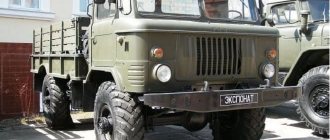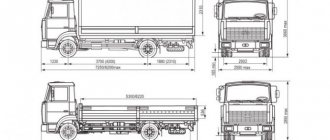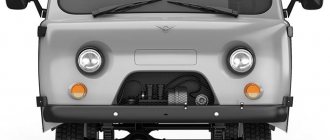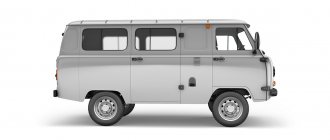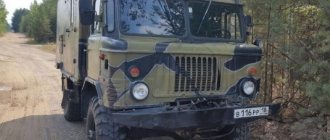“Shishiga” or “bump” (as the GAZ-66 was colloquially dubbed because of the unpronounceable “six-six”) needs no introduction. You don’t have to be a military man to recognize the legendary car, which is still on the move in military units and in agriculture. In terms of mass production, among 2-axle all-wheel drive trucks, the 66th model has no equal - over 40 years of production, about a million copies were produced (956,641 units). Who is the designer of the GAZ-66 - this successful (or still not very successful) model? When it comes to great popularity, you cannot do without beautiful legends.
Modifications of GAZ-66
There are several modifications of the GAZ-66 truck.
- 01 - equipped with a tire pressure regulation system.
- 02 - equipped with a military winch and a tire pressure regulation system.
- 04 - there is electronic control with a screen.
- 15 - has all of the above and a military winch.
- 11 - considered the basic classic model.
- 40 - equipped with a turbo diesel engine.
- 31 — dump truck chassis installed.
- 41 - a naturally aspirated diesel engine is installed.
- 40 – turbo diesel GAZ-5441 installed.
- 92 - made specifically for the northern regions of the country.
- 96 - equipped with bus chassis.
The designers produced a car with increased stability and power.
Increased cross-country ability of the GAZ-66
For better distribution of load on the axles, the GAZ-66 cabin is located directly above the engine.
Story
The first-born GAZ-66 was shown in 1962. The truck was a modernized 1.2-ton GAZ62 vehicle. He urgently needed a replacement. With its appearance, GAZ-66 also removed GAZ 63 from development.
In 1966, tire inflation was installed on the car. In the same year, the truck received an award at an equipment exhibition in Moscow. In 1967 there was an award in Germany, with this Europe showed its recognition of the truck. And in 1969, the car received the “Quality Mark”. The car was sent to all cities of the Soviet Union.
The GAZ-66 made a great contribution both to agriculture and to the Armed Forces of the country where the GAZ was adopted.
1995 The end of production of such a famous and irreplaceable truck. GAZ-3308 appeared. The last model of the 66th truck was released in 1999. In total, the plant produced 965 thousand GAZ-66 units during the period.
Main technical characteristics of the car
- Has a load capacity of up to 2000 kg;
- Can carry a maximum of 5900 kg;
- The model, together with the winch, has a length of 5.806 m, a width of 2.322 m, and a height of the car without loads of 2.520 m;
drawing of the GAZ 66 truck with dimensions - Cabin height – 2,490 m;
- Ground clearance is 31.5 cm;
- The front wheels create a track of 18 cm, and the rear wheels 17.5 cm. The car turns with a radius of 9.5 meters;
- The car overcomes a ford 800 cm deep;
- The new models have an 8-cylinder, liquid-cooled engine;
- The car has a working volume of 4254 cm3;
- The transfer case has a reduction gear and a switchable front axle;
- Operates with a power of 120 horsepower;
- The gearbox is manual, with 4 steps, synchronizers in 3rd and 4th gears;
- Two drive options - all-wheel drive and rear-wheel drive;
- Wheels are installed on special wheels with a split rim and rings on sides from 8 to 18. Tires – 12 – 18;
- The level of pressure in the wheels is from 0.5 to 3 kg per cm2;
- The maximum speed reaches 90 km/h;
- Fuel tank capacity 210 l;
- At a speed of 70 km/h, the car “eats” 18 liters of gasoline every 100 km;
- Drives on gasoline A-72, A-76, AI-80;
- The car's generator operates at a maximum current of 85 A;
- The battery capacity is 75;
- The cylinder blocks are cast from aluminum, equipped with liners, and covered with anti-corrosion cast iron on top;
- Pistons are tin-plated, made of aluminum;
- Develops maximum power of 115 horsepower at 3200-3400 rpm;
- Electrical equipment operates at 12 Volts;
- Ignition coil B114;
- 4-speed gearbox, manual with synchronization in 2nd and 4th gears;
- 2.8 kg per m2 – pressure indicator in the front and rear tires;
- The pressure can be reduced to 0.5 kg/cm2, but the vehicle speed should be no more than 20 km/h;
- The control mechanism is a worm with hydraulic booster and a gear ratio of 20.8.
Evolution of GAZ 62
0
See all photos in the gallery
×
The design of the GAZ-62 was developed by A.D. Prosvirnin, who at that time held the position of deputy chief designer for trucks at the GAZ association. Prosvirnin was able to take into account the wishes of customers and created a cargo version of the GAZ-62, with a 4x4 wheel arrangement and a carrying capacity of 1 ton. The cabin was located above the engine. Various modifications of such a car were tested with self-locking differentials, and with sealed brakes, and with an engine with pre-chamber-torch ignition of the combustible mixture. As a result of the work, the optimal option for an engine with pre-chamber-torch ignition was found, and in 1959-1960 GAZ produced a batch of several hundred GAZ-62 cars. Operation of this experimental batch showed insufficient power of the six-cylinder engine. The Gaz-51 engine was no longer suitable. By that time, the plant already had the design of a promising V-shaped 8-cylinder engine with a crankcase and cylinder head made of aluminum alloy, and preparations were underway for its mass production. Work on further development of the GAZ-62 design in relation to the capabilities of the new engine was carried out in parallel with the development of the engine. The first prototype of the future GAZ 66 appeared in 1956. An experimental model of an all-terrain vehicle with a modified tail of the produced 51/63 cabin. The vehicle is built on the GAZ 63V platform with a widened track.
Engine Specifications
Engine capacity is 4250 cm3, runs on AI-76 and AI-80 gasoline. The car is designed even for severe operating conditions and develops power up to 120 horsepower at 3200 rpm.
This is what a GAZ-66 engine looks like.
Diesel is practically not installed on gas 66, mainly gasoline engines. The car can reach speeds of up to 90 km/h, but when the limiter is removed, the engine can be accelerated to 110-120 km/h, which reduces the service life and causes the mechanisms to wear out.
Advantages and disadvantages of a diesel engine
There are practically no disadvantages in modern diesel engines. There was a time when it was difficult to start a diesel engine in cold weather. These days, cold starts use glow plugs and good synthetic motor oil. The reduced level of oil solidification makes it easy to crank the internal combustion engine crankshaft even at ambient temperatures below -30ºC.
Advantages of diesel engines over gasoline engines:
- High efficiency.
- More efficient efficiency due to high compression ratio.
Diesel engine operation diagram
- Long service life, mileage before the first major overhaul can be 400 or 500 thousand km.
- Easier to diagnose and configure.
Gearbox Specifications
GAZ-66 was developed specifically for work in difficult terrain. The gearbox is mechanical, four-speed. The car successfully overcomes steep slopes. If driving on a road with good surface, the driver has the opportunity to disable the front axle to save fuel.
The car is equipped with 2 tanks of 105 liters each, which makes it possible to travel up to 800 km at a speed of 25 km/h. But when working in real conditions, the numbers come out differently.
GAZ-66 gearbox diagram
Design and device
The truck is based on a frame structure made of high-strength steel, whose simplicity only enhanced the reliability of the vehicle. The ability to travel off-road is provided. Since 1968, the car has been equipped with a tire pressure regulation system. In combination with 4-wheel drive, high ground clearance and a fairly powerful engine for its time, this successfully balanced the entire structure, providing the truck with the ability to drive freely even where other wheeled vehicles were no longer capable of this.
Short description
GAZ-66 is distinguished by a high level of power, reliability and wear resistance. Passes on any roads with heavy loads. The car is capable of transporting 2 tons of cargo off-road.
The differential locking of the front and rear axles is carried out automatically, large clearances and pressure regulation in the wheels create excellent cross-country ability (the wheel rims are designed according to a special design), and a special engine-driven device is installed to inflate the tires. The gas 66 engine is equipped with a pre-start heater.
In operating condition, a gas 66 brake system with separate hydraulics and a vacuum booster is used, and when parked, drum brakes with a transmission are used. The hydraulic booster is controlled using the steering wheel.
Power steering diagram
One of the technical features of the truck is the ideal balancing of the center of gravity, the vehicle is distinguished by its compactness, and the cabin is located above the engine itself, which allows the load to be evenly distributed between the front and rear axles, which is why the vehicle was used by airborne troops: during a parachute drop, the vehicle lands on all 4 wheels and does not fall over.
But in the 80s of the last century, the car was not used in Afghanistan because of m, which increased the danger during a mine explosion.
That is why the GAZ-66 was withdrawn from Afghanistan and decided to be mothballed at military bases. But the equipment had to stand in mothballed form for a long time, so the oil seals and tires, and the engines, deteriorated. In the 90s of the last century, the Ministry of Defense began selling previously mothballed equipment.
military model GAZ-66 with a kung.
The kung was especially popular - a car in which radio stations were located. In the 90s, the GAZ-66 began to be written off en masse, and then the GAZ 3308 with an extended chassis came to replace it.
KUNG of various configurations
A reliable frame made of high-strength steel, which is the basis of the GAZ “66-11”, allows you to mount on it two drive axles with spring suspension, an engine with transmission elements, a cabin that rises on hinges and opens up the ability to work with the engine, as well as different body options.
These cars had the following features and technical characteristics:
- «66-12» is a model of a modernized truck with an installed winch and PTO.
- «66-14» — with this marking, a chassis with shielded electrical wires and assemblies, as well as a PTO, was produced for eleven years.
- «66-15» — a machine with shielded equipment and a mechanical winch.
- «66-21» - a version of a car for the needs of the national economy with dual rear wheels and a wooden loading platform.
- “66-31” - under this marking the chassis was produced, on which dump trucks were installed at the Saransk plant.
Such dump trucks with all-wheel drive for agricultural needs were called GAZ-SAZ-3531 and had good technical characteristics. - «66-92» - This is a version of the car for northern latitudes with a difficult climate.
- «66-96» — chassis for installing a KUNG on a rotation bus.
The “66-11” chassis, on which specialized KUNGs or bodies were mounted, received separate markings. For example, for the national economy the following were produced:
- mobile workshops for repairing agricultural machinery;
- for medical needs - clinics on wheels ;
- utility vans for transporting bakery products, postal items or medicines;
- mobile drilling rig ;
- rotation buses with a warm body - NZAS-3964 and Volgar-39461;
- An all-wheel drive version of the PAZ-672 bus - PAZ-3201 was also produced
Do you know the operating parameters of the Tatra 148 engine, which runs on diesel fuel? By clicking on the following link https://spez-tech.com/tehnika/gruzovie-avto/ural/5557-harakteristiki-preimushhestva-i-nedostatki.html, you can familiarize yourself with the technical characteristics of the Ural-5557 dump truck.
At this address you will find the most common models of Grunwald semi-trailers.
The largest number of such special vehicles were produced for army needs:
- command and staff all-terrain vehicle R-142 ;
- oil tanker MZ-66 and alcohol tanker of the same type;
- medical vehicle for transporting the sick and wounded - AS-66 ;
- mobile sanitary station - mobile dressing station AP-2 ;
- DDA-2 - disinfection unit with shower;
- A rocket launcher, BM-21V, .
The withdrawal of this vehicle from the regular army schedule was facilitated by the fighting in Afghanistan.
It turned out that during a real mine explosion, the crew of the vehicle in the cockpit received significant damage. This was due to the fact that the cabin was located above the wheels, that is, in the blast zone.
In the nineties, on the basis of this all-terrain vehicle, the GAZ-3308 “Sadko” was designed, on which the power plant was located in front.
Nevertheless, the GAZ-66 is still used by airborne and border troops due to its unique qualities.
Car body characteristics
The body length is 5.8 m, width – 2.3 m, height – 2.5 m, which makes the car one of the most compact dump trucks in the world; wheelbase – 3.3 meters.
Drawing of a GAZ-66 car
The track width of the front wheels is 18 cm, the rear wheels are 17.5 cm, this means that on a simple road the car does not go beyond the track. In the prepared state, the weight of the machine reaches 3640 kg, and together with the load it is equal to 5970 kg. The load is distributed as follows: more than 2.7 tons fall on the front axle, and 3 tons on the rear axle.
The car will be able to carry 2 tons even on difficult terrain without damage.
The cabin is located high, which improves visibility for such a hoodless dump truck. But, according to drivers, it is difficult to constantly work at such a height. The cabin is extremely small, so when driving over rough terrain there is a risk of injury from impacts on the interior of the cabin. Access to the engine compartment is difficult.
But the dump truck automatically wins due to its uniform weight distribution and its compact dimensions, as well as the wide functionality that the GAZ-66 Kung model has. The car can be equipped with various equipment, a military winch, and a welding machine.
Principle of operation
Under certain driving conditions, the bridge may not lock. In some cases, when the friction coefficient exceeds a certain indicator - 0.8 of the total force, the differential is locked or not locked. However, the driver still has the option of forced locking. If the bridge is not blocked, then it is necessary to create conditions for its blocking. You can consciously block the axles by performing the following actions: engage a lower gear, add gas, then press the brake pedal and sharply release the clutch pedal. One or more clicks should be heard in the bridges, which will mean they are blocked. In a word, a sharp effort is required, which often occurs unconsciously when you get stuck and start to rock your way out.
The differential works as follows: when the vehicle moves in a straight line, all parts of the differential rotate as one unit together with the driven gear of the main gear. The torque from the driven gear of the main transmission is transmitted to the separator, and from it through the cracks wedged between the cams to the sprockets and axle shafts. In this case, it is distributed equally between the wheels. When one wheel begins to rotate at a higher speed, the differential sprockets begin to rotate at different frequencies. The sprocket connected to the slowly rotating wheel also rotates more slowly, which becomes the reason for pushing the crackers towards the second sprocket, thereby accelerating its rotation.
Controllability
The vehicle's high cross-country ability is ensured by self-locking differentials and a fairly large clearance of 31.5 centimeters, which allows it to overcome bodies of water that exceed the ground clearance in depth.
The car is equipped with a separating hydraulic brake system, which will not allow you to move with the coasting on. But the hydraulic power steering makes it easier to handle difficult turns.
One of the main features of the car: the ideal location of the center of gravity, so the load is simply not felt.
Differences
The GAZ-66 dump truck differs from other trucks in cross-country ability. The machine easily performs work, both on a bad road and without a hint of a road at all. To achieve this, the chassis of the car was constantly improved:
- Distance from the road to the bottom of the car.
- The bridge block itself is blocked.
- The designers installed a wheel inflation system.
Another distinctive feature of the truck is the adjustable center of gravity. Its function was to provide a center of gravity on the axle at the rear and front.
Body and cabin
The cabover design with the shortened overall dimensions of the entire vehicle made it possible to increase the size of the cargo platform and lower its landing, making loading and unloading easier. The body platform of the standard truck was metal with wooden sides (latticed side and hinged rear). Folding benches were installed inside the body for transporting people, and it was also possible to install an awning.
Cabin GAZ-66 from the inside
The GAZ-66 cabin was all-metal and was designed for two seats. For long trips, it was possible to install a hanging hammock. In the first models for the Airborne Forces, a cabin from the GAZ-62 with a fabric roll-up roof and removable door extensions was used, but after a few years, with the expansion of the capabilities of military transport aviation, this version ceased to be relevant.
Operating and repair instructions
While using the vehicle, it is necessary to adhere to safety regulations, promptly repair detected breakdowns, and replace consumables and technical fluids. All maintenance and care operations are described in the operating and repair instructions for the truck.
Maintenance of performance leads to an increase in the service life of the vehicle, reliable and safe driving.
Maintenance and routine repairs of the GAZ-66 come down to checking the operating condition, adjusting parts, and diagnosing systems.
To repair a truck, contact specialized workshops or perform technical work yourself, according to the repair manual.
How to bleed the brakes
When the machine is used for a long time, the friction linings of the brakes wear out. At the same time, the gap between them and the drums increases, which leads to poor pedal performance during braking and constant and strong squeezing of the clutch. To eliminate the problem, bleed the brake system. The current brake adjustment is aimed at restoring the clearance.
You need to bleed the brakes on a GAZ like this:
- First you need to disconnect the eccentric bolt of the intermediate lever from the pusher device.
- Remove the brake master cylinder.
- Separate the pads.
- Check all pedal positions.
- Install the pusher until it stops.
- Reassemble the parts in reverse order.
How to adjust valves
Valve adjustment sequence:
- Remove the rocker cover.
- Remove the spark plug for the first cylinder.
- Set the piston to top dead center (TDC).
- Rotate the crankshaft until the pointer on the clutch housing aligns with the flywheel ball.
- Check the gap with a feeler gauge. It should be 0.25-0.3 mm on a cold engine. If necessary, adjust by turning the adjusting screw.
- Install the parts in reverse order.
How to set the ignition
Algorithm for installing the ignition:
- Turn out the spark plug of the first cylinder.
- Close the hole for the spark plug with your finger and turn the crankshaft until the compressed air comes out.
- Remove the hatch cover on the crankcase clutch and observe the marks on the engine flywheel.
- Rotate the crankshaft until the pointer on the clutch housing coincides with the ball cased into the flywheel.
- Install the distributor drive.
- Check and adjust the gap in the breaker.
- Insert the distribution mechanism into the drive hole and secure with a screw.
- Connect the high and low voltage wires from the ignition coil and the high voltage wires from the spark plugs in the order 1-5-4-2-6-3-7-8.
- Set the ignition timing.
How to bleed the clutch
Correct clutch is to set the free play of the outer end of the release fork to 4-5 mm.
The clutch stroke is adjusted as follows:
- The release spring is detached.
- The stroke is measured. If it is less than the set parameter, the locknut is loosened and adjusted by rotating the pusher.
- Put on the spring.
Noise during operation, knocking noise during sudden changes in rotation speed, difficult gear shifting or self-switching of direct transmission may be associated with problems in the transmission. In these cases, the transfer case and driveline are repaired.
How to set up a carburetor
Tuning the carburetor means adjusting its basic parameters, checking the fuel level in the float chamber and the tightness of the float and fuel valve.
The basic parameters must be configured as follows:
- Adjust the timing of turning on the economizer.
- Check the valve for tightness.
- Check the performance of the accelerator pump.
- Calculate the throughput of the jets using special devices.
How to reduce fuel consumption
If you turn on the front axle of a truck with a gasoline engine, you can reduce fuel consumption by up to 10%. The reduction gear is rigidly connected to the intermediate shaft. The movable gear for engaging the front axle is mounted on the splines. When you move it in the opposite direction, the bridge turns on. When moving forward, the flywheels of the drive shaft contact the elements of the intermediate shaft, thereby activating the reduction gear.
Use in combat conditions
A balanced center of gravity and the ability to land smoothly on all wheels made the GAZ-66 an optimal vehicle for airborne troops. The truck was parachuted from an airplane using a fairly simple landing platform.
In 1965, the Gorky Automobile Plant developed a three-axle version of trucks based on the GAZ-66 with a 6x4 (GAZ-33) and 6x6 (GAZ-34) wheel arrangement. But the Soviet defense department did not approve of these models, considering their functions to be unnecessary duplication of the ZIL-131, which has a payload capacity of about 3.5 tons.
The initial period of production of the GAZ-66 for the needs of the Soviet Army fell on quiet years, but the first serious military conflict - in Afghanistan - revealed a serious vulnerability of the cabover vehicle: poor protection of its cabin. In the event of a mine explosion, the driver and passenger were at least injured, and often died. Therefore, the GAZ-66 was very soon withdrawn from the combat units operating in the DRA.
However, the effective combat use of the GAZ-66 in local and civil wars was achieved through its conversion into a formidable fire support vehicle (“gantruk”). Placing a ZU-23-2 anti-aircraft gun in the back of the Shishiga, capable of firing at ground targets, brought success during many military conflicts in the Middle East and Africa, and later in the operations of Russian troops in the North Caucasus. The latest example in this series is still the conflict in eastern Ukraine.
"Gantrak" based on GAZ-66 in action
Comparison with competitors
For its time, when the GAZ-66 was still in production, this car simply had no direct competitors. In Soviet times, the ZIL-131 and GAZ-53 can only to some extent be considered its analogues, but these vehicles were created for other tasks and happily occupied their own niche in cargo transportation.
Among similar military vehicles abroad, few could withstand comparison with the GAZ-66 in terms of maneuverability, simplicity and reliability. These include only the Mercedes-Benz Unimog line and later models Renault TRM 2000 and Hino Type 73 Chugata.
The first attempt to replace the “shishiga” with a newer model (GAZ-3301) occurred during the collapse of the USSR and, for this reason alone, was unsuccessful. Only towards the end of the 1990s did the GAZ-3308 “Sadko” model appear, which became the basis for the next generation of army off-road trucks.
